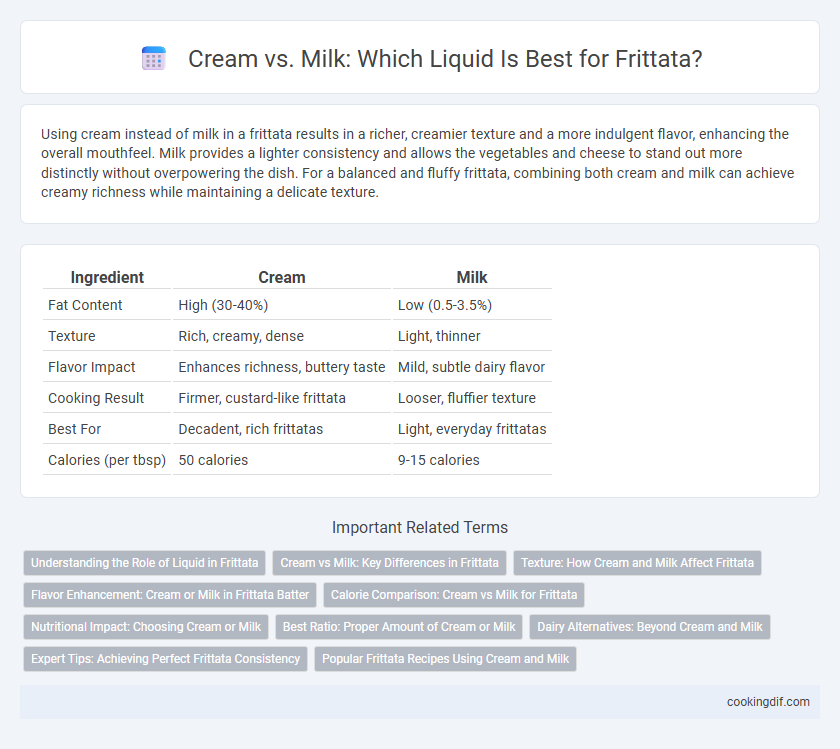Using cream instead of milk in a frittata results in a richer, creamier texture and a more indulgent flavor, enhancing the overall mouthfeel. Milk provides a lighter consistency and allows the vegetables and cheese to stand out more distinctly without overpowering the dish. For a balanced and fluffy frittata, combining both cream and milk can achieve creamy richness while maintaining a delicate texture.
Table of Comparison
| Ingredient | Cream | Milk |
|---|---|---|
| Fat Content | High (30-40%) | Low (0.5-3.5%) |
| Texture | Rich, creamy, dense | Light, thinner |
| Flavor Impact | Enhances richness, buttery taste | Mild, subtle dairy flavor |
| Cooking Result | Firmer, custard-like frittata | Looser, fluffier texture |
| Best For | Decadent, rich frittatas | Light, everyday frittatas |
| Calories (per tbsp) | 50 calories | 9-15 calories |
Understanding the Role of Liquid in Frittata
The choice between cream and milk significantly impacts the texture and richness of a frittata, with cream providing a denser, more custard-like consistency due to its higher fat content. Milk, being lighter, results in a fluffier, airier frittata while allowing other flavors like vegetables and cheese to shine more prominently. Understanding the moisture and fat balance is crucial, as too much liquid can hinder proper setting, while too little can make the frittata dry and tough.
Cream vs Milk: Key Differences in Frittata
Cream and milk differ significantly in fat content, which affects the texture and richness of a frittata. Using cream results in a denser, creamier consistency, while milk produces a lighter, fluffier outcome. The choice between cream and milk impacts the frittata's moisture level, flavor intensity, and overall mouthfeel.
Texture: How Cream and Milk Affect Frittata
Cream enriches frittata texture, resulting in a denser, silkier bite due to its higher fat content, which adds moisture and smoothness. Milk produces a lighter, fluffier frittata with a more delicate crumb, as its lower fat content allows eggs to aerate more during cooking. Choosing cream or milk directly influences the frittata's mouthfeel and richness, tailoring the dish to preferred texture and flavor intensity.
Flavor Enhancement: Cream or Milk in Frittata Batter
Using cream in frittata batter significantly enhances flavor by adding a rich, velvety texture and deeper taste compared to milk. Milk contributes moisture but offers a lighter, more subtle flavor profile, making the dish less decadent. For a more indulgent and flavorful frittata, cream is the preferred liquid choice.
Calorie Comparison: Cream vs Milk for Frittata
Cream contains approximately 50 calories per tablespoon, significantly higher than milk's 9 to 12 calories per tablespoon, making milk a lower-calorie option for frittata preparation. Whole milk provides a richer texture with fewer calories compared to heavy cream, which can add up to 100 calories or more per serving in a frittata. Choosing milk over cream reduces overall calorie intake while maintaining moisture and enhancing the frittata's lightness.
Nutritional Impact: Choosing Cream or Milk
Cream contains higher fat content and more calories than milk, significantly increasing the richness and energy density of a frittata. Milk offers lower fat and calorie levels, providing a lighter texture while supplying essential nutrients like calcium and vitamin D. Selecting cream enhances flavor and creaminess but raises saturated fat intake, whereas milk supports a balanced nutritional profile with reduced fat.
Best Ratio: Proper Amount of Cream or Milk
Using cream in a frittata enhances richness and creates a custard-like texture, with the ideal ratio being about 1/4 cup of cream per 6 large eggs. Milk, offering a lighter consistency, pairs best at roughly 1/3 cup per 6 large eggs, balancing moisture without overpowering the eggs. Properly adjusting this liquid-to-egg ratio ensures a tender, moist frittata with optimal fluffiness and flavor.
Dairy Alternatives: Beyond Cream and Milk
Frittata recipes often call for dairy liquids like cream or milk, but plant-based alternatives such as almond milk, coconut cream, or oat milk provide excellent substitutes for those seeking dairy-free options. Coconut cream delivers a rich, creamy texture similar to heavy cream, enhancing the frittata's moisture and flavor without dairy. Almond or oat milk offers a lighter consistency, contributing subtle sweetness and maintaining the dish's overall structure while catering to vegan and lactose-intolerant diets.
Expert Tips: Achieving Perfect Frittata Consistency
For achieving the perfect frittata consistency, experts recommend using cream over milk due to its higher fat content, which results in a richer, creamier texture. Cream helps maintain moisture and creates a tender, custard-like interior, preventing the frittata from becoming rubbery or dry. Milk, while lighter, often leads to a firmer texture and may require careful cooking to avoid over-drying the eggs.
Popular Frittata Recipes Using Cream and Milk
Popular frittata recipes often debate the use of cream versus milk as the liquid base, with many chefs favoring cream for its rich texture and enhanced flavor. Milk is commonly chosen for a lighter, fluffier frittata, providing a balanced custard consistency without overwhelming richness. Recipes like classic Italian frittata typically use milk, while more indulgent versions with cheese and vegetables lean towards cream to create a denser, creamier dish.
Cream vs Milk for liquid Infographic

 cookingdif.com
cookingdif.com